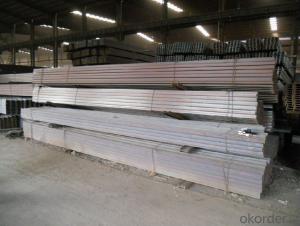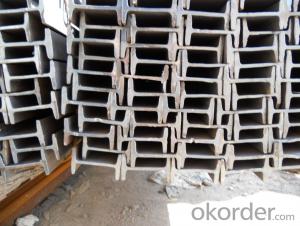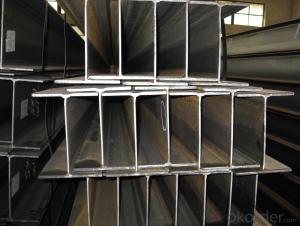European Standard IPE100/IPE120 High Quality
- Loading Port:
- China main port
- Payment Terms:
- TT OR LC
- Min Order Qty:
- 50 m.t.
- Supply Capability:
- 10000 m.t./month
OKorder Service Pledge
OKorder Financial Service
You Might Also Like
Item specifice
Product Description of European Standard IPE100/IPE120 with High Quality
Specifications
1.Standard: EN10025
2.Material: S235JR or Equivalent
3.Length: 6m, 12m
4. Size:
| Size(mm) | Mass(Kg/m) |
| 100*55*4.1 | 8.10 |
| 120*64*4.8 | 10.40 |
Usage & Applications
Commercial building structure;
Pre-engineered buildings;
Machinery support structures;
Prefabricated structure;
Medium scale bridges.
Packaging & Delivery
1. Transportation: the goods are delivered by truck from mill to loading port, the maximum quantity can be loaded is around 40MTs by each truck. If the order quantity cannot reach the full truck loaded, the transportation cost per ton will be little higher than full load.
2. With bundles and load in 20 feet/40 feet container, or by bulk cargo, also we could do as customer's request.
3. Marks:
Color mark: There will be color marking on both end of the bundle for the cargo delivered by bulk vessel. That makes it easily to distinguish at the destination port.
Tag mark: There will be tag mark tied up on the bundles. The information usually including supplier logo and name, product name, made in China, shipping marks and other information request by the customer.
If loading by container the marking is not needed, but we will prepare it as customer's request.

- Q:Can steel H-beams be used in the construction of shopping malls or retail buildings?
- Yes, steel H-beams can be used in the construction of shopping malls or retail buildings. Steel H-beams are commonly used in the construction industry due to their strength, durability, and versatility. They provide structural support and stability to large structures like shopping malls or retail buildings, making them ideal for such projects. The H-beams can be used for framing, columns, beams, and other load-bearing elements in the construction process. Additionally, steel H-beams are cost-effective and can be easily assembled, making them a popular choice in commercial construction projects. Overall, steel H-beams are a suitable and reliable option for the construction of shopping malls or retail buildings.
- Q:Can steel H-beams be used in residential towers and high-rise buildings?
- Residential towers and high-rise buildings can indeed utilize steel H-beams. These beams are widely employed in the construction industry because of their robustness and longevity. Their ability to endure substantial loads and provide structural stability makes them well-suited for tall structures. The H shape of the beams allows for improved distribution of weight, a crucial aspect in high-rise construction. Moreover, steel H-beams possess fire-resistant qualities, a vital safety feature in residential towers and high-rise buildings. All in all, the strength, durability, and fire-resistant properties of steel H-beams make them a favored option in the construction of residential towers and high-rise buildings.
- Q:What are the different types of steel used in manufacturing H-beams?
- H-beams are manufactured using various types of steel. Some commonly used steels for H-beams include: 1. Mild Steel: This is the most frequently utilized steel type for H-beams due to its low carbon content and affordability. Mild steel is highly versatile and finds widespread use in construction projects. 2. High-Strength Low-Alloy (HSLA) Steel: HSLA steel is an alloy steel that offers greater strength and superior resistance to corrosion compared to mild steel. It is preferred for heavy-duty applications where durability is crucial. 3. Carbon Steel: Carbon steel is a steel variant in which carbon serves as the primary alloying element. It is renowned for its high strength and hardness. Carbon steel H-beams are commonly employed in structural applications where strength is of utmost importance. 4. Stainless Steel: Stainless steel contains chromium, providing it with exceptional resistance to corrosion. It is commonly applied in environments susceptible to corrosion, such as coastal areas or chemical plants. 5. Weathering Steel: Also known as corten steel, weathering steel develops a protective rust-like coating when exposed to the elements. It is widely used in outdoor structures and bridges due to its corrosion resistance. 6. Alloy Steel: Alloy steel comprises additional elements like manganese, nickel, or chromium to enhance its properties. It is frequently utilized in specialized applications that necessitate specific characteristics, such as high temperature resistance or wear resistance. These examples represent only a fraction of the steel types employed in H-beam manufacturing. The choice of steel depends on factors like intended usage, budget, and desired properties of the H-beam.
- Q:How do steel H-beams contribute to occupant comfort in buildings?
- Occupant comfort in buildings is greatly enhanced by steel H-beams, which serve various important functions. Firstly, these beams ensure the structural stability and support of the building, thus maintaining its overall integrity. This stability reduces the risk of structural failures that can cause discomfort and safety concerns for occupants. Furthermore, steel H-beams have a high load-bearing capacity, allowing for larger spans and open floor plans. This design flexibility enables architects to create more spacious and comfortable living and working areas without the need for excessive columns or supports, which can hinder occupant movement and affect the aesthetics of the space. In addition, steel H-beams are recognized for their fire resistance and durability. They can withstand higher temperatures in the event of a fire compared to other construction materials, ensuring the safety of occupants and minimizing the spread of flames. The structural strength of steel H-beams also contributes to the long-term durability of the building, reducing the need for major repairs or renovations that can disrupt occupant comfort. Moreover, steel H-beams possess excellent sound insulation properties, reducing the transmission of noise between different areas of the building. This is particularly important in multi-story buildings or those located in busy urban areas, where external noise can be a significant source of discomfort. The reduced noise levels create a quieter and more peaceful environment for occupants, promoting their well-being and productivity. Lastly, the use of steel H-beams allows for the efficient installation of HVAC systems. Their lightweight nature and high strength-to-weight ratio enable the placement of ductwork, piping, and other HVAC components without excessive load-bearing concerns. This flexibility in HVAC design ensures optimal temperature control, ventilation, and air quality, all of which contribute to occupant comfort and well-being. In conclusion, steel H-beams significantly enhance occupant comfort in buildings by providing structural stability, enabling open floor plans, offering fire resistance and durability, insulating against sound transmission, and facilitating efficient HVAC systems. These features collectively improve the overall comfort and safety of occupants, creating a pleasant and enjoyable environment for living and working.
- Q:Are steel H-beams compatible with different construction materials?
- Yes, steel H-beams are compatible with different construction materials. Due to their versatility and strength, steel H-beams can be used in a wide range of construction projects and are compatible with various materials such as concrete, wood, and masonry. They can be used as structural support elements in building frames, bridges, and other infrastructure projects. The ability of steel H-beams to withstand heavy loads and provide stability makes them a preferred choice for combining with different construction materials in various applications.
- Q:What are the common applications of steel H-beams?
- Steel H-beams have a wide range of uses in the construction industry, particularly in structural and civil engineering. Some common applications of steel H-beams include: 1. Building Construction: Steel H-beams are frequently utilized as load-bearing elements in building construction and other structures. They offer exceptional strength and stability, making them ideal for supporting heavy loads and withstanding various forces like wind and earthquakes. 2. Bridges: Steel H-beams are extensively employed in bridge construction due to their ability to endure high loads and support large spans. They are commonly used as primary girders and piers, providing the necessary structural support to ensure bridge stability and durability. 3. Industrial Structures: Steel H-beams are commonly employed in the construction of industrial structures like warehouses, factories, and power plants. These structures often require large open spaces without the need for intermediate columns, and steel H-beams can provide the necessary strength and rigidity to meet these requirements. 4. Mezzanine Floors: Mezzanine floors are intermediate floors constructed within buildings to create additional usable space. Steel H-beams are frequently used to support these floors due to their ability to efficiently bear the weight of added loads and allow for flexible space utilization. 5. Platforms and Walkways: Steel H-beams are often utilized in constructing platforms and walkways in industrial settings such as oil refineries, chemical plants, and power stations. These structures demand high strength and stability to ensure worker and equipment safety, and steel H-beams are well-suited for this purpose. 6. Steel Frames: Steel H-beams are an integral part of constructing steel frames for various structures. They act as the skeleton of the building, providing the necessary support and stability to the overall structure. 7. Architectural Applications: Steel H-beams are also used in architectural applications to create unique and visually appealing structures. They can serve as decorative elements like exposed beams and columns, enhancing the visual appeal of buildings. In conclusion, steel H-beams have diverse applications in the construction industry, including building construction, bridges, industrial structures, mezzanine floors, platforms and walkways, steel frames, and architectural designs. Their strength, stability, and versatility make them an indispensable component in various construction projects.
- Q:Can steel H-beams be used for agricultural structures?
- Yes, steel H-beams can be used for agricultural structures. Steel H-beams provide excellent structural support and can be used for various agricultural applications such as barns, warehouses, and equipment storage buildings. They offer high strength and durability, making them suitable for withstanding heavy loads and adverse weather conditions. Additionally, steel H-beams are versatile and can be easily customized to meet specific requirements, making them a popular choice for agricultural construction.
- Q:What are the design considerations for steel H-beams in cold climates?
- To guarantee the structural integrity and effectiveness of steel H-beams in cold climates, there are several vital factors that need to be considered during the design process. These considerations are as follows: 1. Material Selection: It is crucial to select the appropriate grade of steel for cold climates. Steel grades with higher yield strength and toughness, such as ASTM A572 or A588, are recommended due to their ability to withstand low temperatures and resist brittle fracture. 2. Impact of Cold Temperatures: Cold temperatures can make steel more brittle, increasing the risk of fracture. Designers should take into account the effects of low temperatures on the steel's ductility and toughness, and consider potential temperature variations throughout the year. 3. Structural Stability: Cold climates often experience severe weather conditions, including heavy snow loads and strong winds. Designers must ensure that the H-beams have sufficient load-bearing capacity and stability against lateral forces. It is necessary to consider not only the weight of the snow but also the potential impact of snow drifts on the beams. 4. Thermal Expansion and Contraction: Steel expands and contracts with temperature fluctuations. In cold climates, where temperatures can vary significantly between seasons, it is vital to incorporate proper expansion joints and allow for thermal movement. This prevents excessive stress and potential damage to the H-beams. 5. Corrosion Protection: Cold climates often have high levels of moisture, which can accelerate the corrosion process. Designers should consider using protective coatings, such as galvanizing or epoxy, to prevent rust and prolong the lifespan of the H-beams in these environments. 6. Insulation: In extremely cold climates, insulation can be utilized to minimize heat transfer and reduce the risk of thermal bridging. This, in turn, helps prevent condensation and potential corrosion. Careful integration of insulation into the design is necessary to maintain the structural integrity of the H-beams. 7. Connection Design: Proper design of connections between H-beams is crucial to ensure their performance in cold climates. Connections should be designed to accommodate potential movement due to thermal expansion and contraction, while maintaining structural stability and load-bearing capacity. By considering these design factors, engineers can ensure that steel H-beams perform optimally and have a long lifespan in cold climate environments.
- Q:How do steel H-beams contribute to the overall aesthetics of a building?
- Steel H-beams contribute to the overall aesthetics of a building by providing a sleek and modern appearance. Their clean lines and structural integrity create a visually appealing framework that adds a sense of strength and stability to the structure. Additionally, the ability to span long distances without the need for additional support columns allows for open and spacious interior designs, enhancing the overall aesthetic appeal of the building.
- Q:Can steel H-beams be used in warehouse or distribution center construction?
- Yes, steel H-beams can be used in warehouse or distribution center construction. Steel H-beams are typically used as structural supports and provide strength and stability to the building structure. They are commonly used in industrial and commercial construction projects due to their durability and load-bearing capabilities.
1. Manufacturer Overview |
|
|---|---|
| Location | |
| Year Established | |
| Annual Output Value | |
| Main Markets | |
| Company Certifications | |
2. Manufacturer Certificates |
|
|---|---|
| a) Certification Name | |
| Range | |
| Reference | |
| Validity Period | |
3. Manufacturer Capability |
|
|---|---|
| a)Trade Capacity | |
| Nearest Port | |
| Export Percentage | |
| No.of Employees in Trade Department | |
| Language Spoken: | |
| b)Factory Information | |
| Factory Size: | |
| No. of Production Lines | |
| Contract Manufacturing | |
| Product Price Range | |
Send your message to us
European Standard IPE100/IPE120 High Quality
- Loading Port:
- China main port
- Payment Terms:
- TT OR LC
- Min Order Qty:
- 50 m.t.
- Supply Capability:
- 10000 m.t./month
OKorder Service Pledge
OKorder Financial Service
Similar products
New products
Hot products
Related keywords



























